It’s getting harder to find what you want at the grocery store. Inflation is driving up prices. And there is no end in sight. Starting a seedbank now will help you prepare for the upcoming food crisis.
A seedbank will ensure that you have what’s necessary on hand to feed your family when SHTF.
So what are you waiting for? Let’s get started.
What Is A Seedbank?
A seedbank is a collection of many different varieties of seeds properly stored to ensure the highest germination rate.
They exist both on a large scale, run by governments and trusts, as well as on a smaller community and family-scale.
Currently, you may simply supplement your diet with food from your garden.
But during a food shortage, you may find yourself forced to consume all your food from your land. In order to do this, you will need a wide selection of seeds to plant.
⇒ How To Build A Hidden Food Growing Fence In Your Backyard
You will want traditional garden staples like tomatoes and cucumbers in your seedbank and a wide selection of grains and medicinal plants.
If you keep animals on your land, don’t forget to consider what their feed needs are as well.
How To Best Store Your Seeds
You want to store your seeds in a way that will protect them until they are ready to plant. The best way to store them is in air-tight containers.
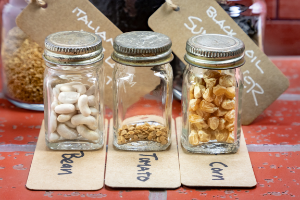
Glass jars with rubber seals are an excellent way to keep seeds safe. The jar protects them from animals, mold, and other factors that can decrease their germination rate.
I’ve also had great luck with seeds stored in mylar bags. These bags can be a good option if you are short on space.
Government run seed banks are often located deep underground in caves. So if you have a root cellar or a basement, that can be a good option if it isn’t too damp.
Dampness is very bad for seed storage. One way to help protect your seeds from humidity is to use silica desiccation packs or even rice to help absorb excess moisture.
Where To Get Your Seeds
The best place to get seeds for your seedbank is from plants already growing in your garden. Saving seed, rather than repurchasing it every season, used to be traditional.
But hybridized and GMO seeds do not produce seeds that will be viable in a second season. So farmers and gardeners have become accustomed to buying new seeds every year.
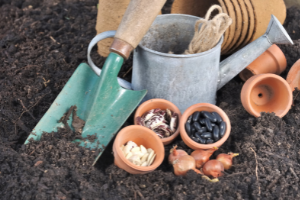
If you plant heirloom varieties rather than GMO or hybridized seeds, then you will be able to break the cycle.
Every season when your fruits or vegetables are ripe, you set a certain part of your harvest for seed. To collect your seeds choose your heartiest, most fruitful, best tasting plants.
If you don’t already have a garden, you can either ask a friend or neighbor who is growing vegetables to share their seeds.
Or you can purchase seeds either from a local nursery or online. Make sure that you purchase heirloom seeds.
⇒ Buy Here A Kit That Has Everything You Need To Start Your Medicinal Herb Garden
This will ensure that you can harvest viable seeds each generation.
Essential Seeds For Your Seedbank
It’s challenging to compile a complete list of every plant you need in your seedbank. Every family has different dietary needs, and different plants grow in different heartiness zones.
However, What you see here is a great place to get started. If you see something missing from my list, by all means, add it!
When building a seedbank, the more seeds and the more varieties you are able to obtain, the better off you will be.
Vegetables
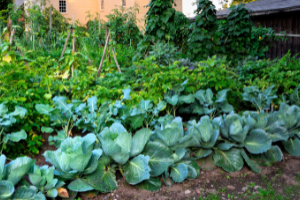 Growing your own vegetables is an easy way to survive a food shortage. Our grandparents knew that when they grew their Victory Gardens. By storing your own seeds, you can always be ready to start that garden. When planning your seedbank, consider which vegetables your family will eat, as well as what will grow best in your area.
Growing your own vegetables is an easy way to survive a food shortage. Our grandparents knew that when they grew their Victory Gardens. By storing your own seeds, you can always be ready to start that garden. When planning your seedbank, consider which vegetables your family will eat, as well as what will grow best in your area.
Also, look to include vegetables that will ripen throughout the year.
Related: How To Preserve Your Vegetables Using Sand
Consider what grows in your area in spring, summer, fall, and winter. Cabbages, for example, can survive pretty cold temperatures.
Onions: Start to plant in early spring. You can begin harvesting as soon as the bulbs reach a usable size.
Garlic: Garlic is best planted in the fall. You then harvest the following summer.
 Tomatoes: You can seed tomatoes directly in your garden.
Tomatoes: You can seed tomatoes directly in your garden.
Just wait until all danger of night frosts has passed.
Plant 3-5 plants for each family member, more if you want to can or preserve your tomatoes for winter.
Cucumbers: Wait until at least two weeks after the last frost before you plant your cucumber seeds in the garden.
For a continual harvest, plant more cucumbers every two weeks. You can begin harvesting cucumber in as few as six weeks.
Peppers: Peppers have a long growing season, so you may want to start your seeds indoors for an earlier harvest. However, you can expect your pepper plants to continue producing right up until the first frost.
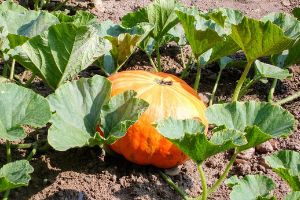 Pumpkins: You want to wait until it’s warm enough outside before planting your pumpkin seeds.
Pumpkins: You want to wait until it’s warm enough outside before planting your pumpkin seeds.
You shouldn’t plant them before late May.
While it may take a while, pumpkins provide an amazing harvest in the fall.
Eggplant: Start your eggplant seeds inside, and they will be ready to transplant after the frost danger has passed. Then they will be ready to harvest around midsummer.
Related: How to Can Eggplant with Pepper for a Long Time Storage
Cabbage: If you want to harvest cabbages in the summer, you will want to start the seeds indoors about two months before your last frost.
Otherwise, you can sew seeds directly in your garden around midsummer for a fall harvest.
Peas: Peas don’t like heat so plant them either in early spring or late fall. Or, if you want two harvests, save seeds from your spring harvest to plant again about six weeks before your first fall frost.
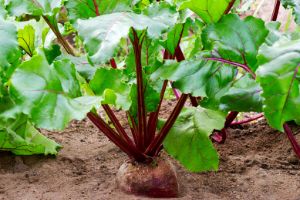 Beets: Beets are a quick, healthy crop.
Beets: Beets are a quick, healthy crop.
They are cold tolerant, so you can plant them early in the spring.
You can harvest after just thirty days after you plant them. This is a dual purpose plant, so don’t forget to eat the delicious greens.
Spinach: For an early spring spinach harvest, you can sew seeds in late fall. Then protect the area with heavy mulch.
You can also plant spinach seeds in late summer and harvest them as the weather cools off in the fall.
Lettuce: Lettuce grows best in cooler seasons like spring and fall, though you can get summer harvests in cooler regions. You can plant seeds every two to three weeks to ensure you always have salad.
Radish: Radish is a fast growing crop that is a great companion to carrots. You can sew the seeds for both crops together. The radishes will be ready to harvest just as your carrot seeds start to sprout.
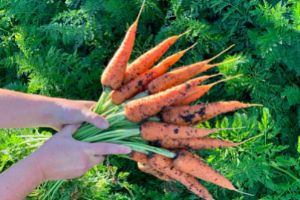 Carrots: Carrots are another vegetable that you can plant early in spring.
Carrots: Carrots are another vegetable that you can plant early in spring.
However, they take longer to mature than beets or radishes.
Expect at least two weeks before you see signs of growth. If you wait until late summer, you can harvest them in fall.
Zucchini: You should wait until all danger of frost has passed before planting zucchini seeds in the garden. Each plant will be very prolific, so just a few plants are usually enough for a family.
Beans: There are many different types of beans out there.
But whether you are planting pole beans or bush beans, you still need to wait until the danger of the last frost has passed.
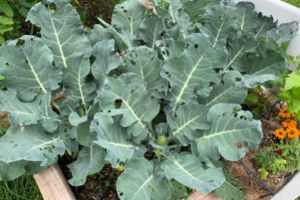 Broccoli: In cooler areas, it’s best to start your seeds indoors before the last frost to ensure your broccoli matures before it is too hot.
Broccoli: In cooler areas, it’s best to start your seeds indoors before the last frost to ensure your broccoli matures before it is too hot.
If you live in a warmer climate, you can direct sew in your garden. Your broccoli will bolt from the summer heat if you don’t plant it early enough.
Fruits
Fruit trees can take a long time to bear fruit, so as the saying goes, “the best time to plant a tree was ten years ago.”
However, it’s always beneficial to have a variety of fruit seeds to plant to start an orchard or just a couple of trees for the family.
Softer fruits will start to mature more rapidly than harder fruits so take that into consideration. Also don’t forget about annuals, like strawberries.
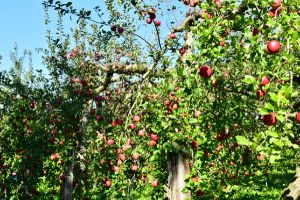 Strawberries
Strawberries- Mulberry
- Peach
- Apple
- Pear
- Citrus
Grain
You will probably want to grow at least one type of grain in your garden. What you choose will be based on your location and how much space you have.
Corn is a great option as it is easier to harvest than wheat if you are not familiar with processing your own grains.
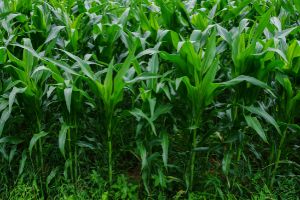 Corn
Corn- Rice
- Wheat
- Sorghum
- Barley
- Oats
Herbs
Herb seeds are an essential part of a survival seedbank. Not only do herbs help liven up your meals, but often they have medicinal uses as well.
A kitchen herb garden can help you survive lean times. There are some of the herbs you should have in your garden: Chamomile, Chicory, Oregano, Yarrow, Marjoram, Feverfew, Rosemary, Thyme, Calendula, Peppermint, Meadowsweet.
Keeping and maintaining a seedbank can help ensure your family’s survival during a food crisis. And really, it’s not difficult to do.
Luckily seeds take up very little room, so that you can store a lot of them in a small space. And if you are already growing a garden, it’s one more step in your harvest.
Think not only of the money you save by not buying seed but the freedom you obtain by being able to feed your family.

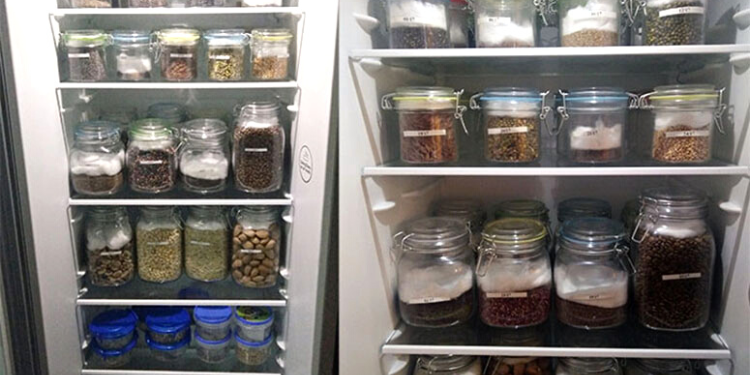













love my garden.
saving my seeds for leaner times.
if I can still buy food, then I will hold on to my seeds.
Fill, it’s smarter to use what we can still get from the store then to use what I have stored up.
When the stores shut down then I will use what I have stored up or When the Buy, Sell and Trade law comes into effect.
That istime to think smarter, don’t work harder. That time will come soon.
Onions, carrots, beets and cabbage are biannual seed producers.
You will need to save several of this years mature crop, overwinter them in damp sand buckets to replant next spring for seed production.
Might also want to plant French marigolds (not pot marigolds aka Caludia) for the many anti-bug and general pest deterrent value. They self seed but folks in zone 5 and worse need to save seeds for nest year.
Michael: Biennials only need so many hours of chill to bloom. Calendula is a food herb, and a healing herb. It’s considered so valuable that during a war, doctors begged housewives to raise a large patch. niio
I’m in Zone 10A and I just leave a container of unharvested carrots outside through the winter, cut way back on the watering, and the next spring they flower and produce seeds. This is my third year doing this, so I am just starting to collect my second batch of carrot seeds as they mature and turn brown. I must say though that separating carrot seeds from the chaff is a pain compared to other seed collecting, so I just settle for a “roughly clean mix” for my carrot seeds and sprinkle the seed/chaff mix when I plant. I’ve tried using mesh screen, which works for Pak Choi seeds, but the carrot seeds are larger and fuzzy so don’t fall through, and neither does all the chaff. have no idea how they get carrot seeds clean for commercial sale, any ideas?
I had a carrot that wouldn’t stop blooming for 3 years. It finally gave it up this summer. niio
I think they use some form of abrasion to remove the little hooks on the outside of each carrot seed. You could try very dry seed between 2 sheets of fine sandpaper. I don’t bother, just use them as they are.
Forgot to say that once you’re in the cycle of saving seeds, every year at least some biennials are flowering so you actually can grow different varieties and keep them pure.
Ginny, I agree, I’m not going to bother cleaning my carrot seeds any more than I already do either. My wife told me I should research producing and selling seeds online as a possible supplemental income after we retire, so I was curious. I can grow a lot more easier and productive seed producers such as onions, Pak Choi, squash, bush and pole beans, tomatoes, bell peppers, eggplant, zucchini and squash, bitter melon, moringa, and so on.
dz: Good idea. I like to start cuttings but give them away. niio
To separate any fuzzy seed from the chafe or fuzz, soak in water for about 15-20 minutes then rub seeds between your fingers in the water. Seeds sink to the bottom and you can discard the floating chafe or fuzz. I do this with lettuce seed also. Works well for many seeds the do not separate readily.
I forgot to mention when you have them separated, skim off the floaties and drain the seeds through a small mesh strainer and dry on a towel. When dry, store in a paper envelope. Be sure to label with all need to know info. Writing the year can get a little bit confusing. On commercial seed packets it has the grown for date which is the next year. To make it less confusing for me I write: Harvested: 20–
Been watching out for my mesquite trees. They have seed pods on them. Will make flour out of them. The drout has made it hard on them making seeds.
Also stinging nettle plants are seeding out, just waiting on them to dry out.
The Milk Weeds are seeding out also.
Plus the Monarch Butterfly lays its eggs on that plant. very important plant for them.
Wild Lettuce is in bloom and seed.
Foraging for wild seeds. You really get to know the plants that you are foraging for and there purpose as medicinal uses.
Plus it’s very relaxing to take a walk in the pasture early, nice and cool. The Donkeys are crying, he haw he haw. lol…
red ant: Mesquite can make a crop on 2 inches of water but is it has to survive on it too long (in years) it may die or go dormant. Here, Zone 9, we can expect 2 crops a year and sometimes 3. Mesquite is all thru the garden because that’s how old-timers always did it (pre-Columbian) for shade, firewood, food, and nitrogen. Leaves are eatable, but proceed with caution. They accumulate nitrogen. We have Western Honey and Velvet. walk in beauty, friend
Never knew mesquite trees could be used to produce flour. Do you grind just the seed or the pods too?? I am assuming you still have to dry the pod and all before use. Good to know this about mesquite tree usage as I have them all over my land. Before reading your input I only thought they were good for firewood and having them popping up everywhere was a nuisance. Now know to just let them grow with some control.
Learning: Good afternoon, kiddo! It’s usual to hang mesquite for about 6 months to complete dry down. They definitely will gum up things (very high in sugar, about 26%). After that, whole pods; a hammermill is good, or, if you haven’t one, a blender. Sieve out the fibers, and only use 10-25% of mesquite in baked goods. BTW, hanging allows any weevils to escape. Not as bad as I’ve seen in flour mills, but not good, anyway. Store in the freezer if you want, that kills them, and always freeze the flour for a few days to make sure nothing is alive in it. Mesquite is said to regulate blood sugar like American beans do. niio
Love that stinging nettle nut, tastes like a macadamia nut/coconut. My dad showed me how to pop it off with two sticks when I was just out of my teens. Brings back good memories
What’s a stinging nettle nut? niio
Stinging Nettle Nuts
Thank you today I learned something very useful 🙂
Red… The nut is at the top of the stalk on the stinging nettle plant, usually only one per plant. Dad used two sticks, long enough to cross over under the center pod, then just tightened it down and popped the nut up into the air and hope it didn’t fall back into the nettle. Could be our stinging nettle here in East Texas is different plant from yours.
Red. Sorry forgot to mention that we went hunting for the stinging nettle nuts along about August/September. Oh…and I am no longer a kiddo, unless 68ish is still young to you, LOL…will have to tell my hubby that one! No longer living in E. TX either, now in central W. TX where it’s hotter than blue blazes and the wind doesn’t just blow, it sucks on a regular basis, too!!
Got to love that Texas heat.
Michael: Thanks, I never knew they were eatable. We liked the leaves steamed and sometimes fried after that, but did not know about the nuts. That’s wind! niio
Learning: Today you’re a spring chicken compared to me. We’re about the same age. I was supposed to unload the truck yesterday (100 lbs each of sulfur and ammonium phosphate sulfate), and a brand new 1940s model modern wringer washer. Between that and parts from one here, I should have one good one. Well, might be it is 2nd hand…maybe a lot more than that LOL. niio, walk in God’s beauty
Could it have been a Texas bull nettle you were popping nuts off?
Foraging Texas
I’m curious about stinging nettle ‘nuts’ mentioned in banter above. The nuts busted off the plant with two sticks!
What genus and specie is this ‘stinging nettle.’
I have dried stinging nettle Urtica dioica with seed pod inflorescences dried in hand towel sheets in front of me, but definitely no ‘nuts.’
Which ‘stinging nettle’ are you referring to? Curious
Common names apply to many & various plants.
Graham
(retired nurseryman, orchardist, vigneron and crop production manager) from Queensland Australia
The article posts some generic planting guidance timeframes and methods that work for SOME areas, but not all, like Zone 10A in Southern California where we live, that gets about 10 inches of annual rainfall, gets 100+ degrees and dry winds off and on from July and into October, has negligible cold periods for fruits that require it to trigger flowering and fruiting such as most apple and pears, and minimal frosts. This means my planting schedule often does not match what is commonly promoted, including the planting timeframes on purchased seed packs, and garderning websites, and requires constantly monitoring the soil moisture and watering accordingly. It’s best to really learn your year-round climate conditions, adjust and plan accordingly.
For me, this means a lot of what I grow often survives through winter even though they are thought of as annuals, such as my strawberries, tomatoes, bell peppers, herbs, onions, carrots, and more. I have more plants that die from dry windy heat than from frost, and a lot of the “greens” bolt super-fast when it gets over 70 degrees, so I’m going to adjust and try to grow my spinach, Pak Choi, Kale, Peas, and and other “greens” during the winter and see if I get better results. I have noticed some plants that are supposed to be “full sun” actually do better in partial sun/partial shade here, such as my bitter melon, pole beans, yard-long beans, spinach, Pak Choi, and bell peppers.
I save seeds every year, package them seperately from previous years seeds, and mark them with the date they were packaged so I can keep track of what they are, and how old they are. The germination rates drop every year after collecting, such as seeds from last year may have a 90% germination rate, but seeds from three years ago may only have a 50% germination rate, such as my sweet corn I planted this year and needed to fill in “gaps” and replant bare spots where I planted three year old seeds.
If you are serious about gardening and producing your own seed bank from what you grow, experiment a lot to see what works better for your conditions, you may be surprised how different it may be compared to the gardening guide “standards”. It is also good to learn which plants you can start from cuttings and “slips”, like I do with potatoes, sweet potatoes, camote, lemon grass, and some of my herbs like organo and basil.
I see my fan-club of “Thumbs Down Trolls” are still following my posts, they must be really bored, or just stupid – probably both.
dz: 40% shade cloth for shade and a windbreak is a major. Without it, no perennials would survive to get hardy enough to come back.
Saving seed is the intelligent way because each generation becomes more in tune with the locale. Those guides of sun or shade are only for the zone the grower is in, not us. Like you, here it’s shade or no go. niio
I bought some shade cloth but haven’t gotten organized enough to put it up yet, and not sure how I want to support it. I’m thinking of using really tall, galvanized fence posts, or look for the long wooden tarp/tent poles with a metal post sticking out one end. Then I will have to figure out how to secure it from the wind so it doesn’t blow down or over into the neighbors.
and both day and night temperatures make a huge difference in how the plants respond, as well as the seasonal changes of daylight hours. still learning but getting better at this.
I use wood poles and hook it to screw nails. But then, big yard so it it does tear fee, it stays in the yard. Most things will only need wind protection for a year or so (perennials, trees, ect). Shade cloth can keep the temp down 10-15 degrees from unshaded. Exposed soil turns into an oven. niio
I have a shade cloth for my chickens. We put T-posts in the ground, slipped PVC pipes over them with 90* elbows on the top end, then stretched another length of PVC between elbows. Found out it is more stable to cement the elbows into the vertical poles and just friction fit the horizontal pole into an elbow on each end. That way, you can disassemble the frame easily. We have the shade cloth draped over the frame in the center of the birds’ pen, then tied down to 6′ high fencing on each end to form a gable roof that the rain and air can flow through. The same idea might work for your garden using 3 frames, one in the center and two at the outer ends but all tall enough to walk under. The nice thing is that the T-posts don’t need to be full height, just 4′ posts will work. And the entire thing is sturdy enough to withstand our W.Texas winds (usually) yet easily disassembled and moved to another location if desired or necessary.
Try freezing your seeds, I keep all of mine in the freezer and they stay good as new. Think about it, Mother nature freezes them and in the spring they sprout. Been doing this for years and it works here in Washington State.
That’s wisdom. I like to toss some radish seed pods on the mulch. These are winter radishes and when they grow, they chase off a lot of unwelcome critters like ground squirrels. The pods take weeks to break down. niio
A fellow Washingtonian here. I hang my corn (Painted Mtn Flint) in the garage to be shelled for planting in the spring, bean and pea seed also. I hang the ears and pods in mesh laundry bags. The garage allows seed to freeze and stay dry until planting time. Planting time wasn’t until June 1 this year. So wet this spring.
Great advice from the article and from experienced gardeners, my main goal in my vegetable garden this year is learning how to save seeds for next year. Growing all heirloom, various beans, corn, pepper, tomato, potato. Year before last a lot of seed companies sold out early, this past spring, not so bad. Hopefully I’ll be a fast learner on this, great for me that so many people already know how.
Quite a few farmers used to buy hybrid seed one year and save enough from the harvest to plant the next year. Hybrid seed the 1st year comes back about 75% true, the all hybrid fields would be plants of perfectly uniform height, the second year seed would have about a quarter of the plants shorter or taller. Performance falls off a lot after the 3rd year. By 1990 Cargill and a few others had bought out almost all the small seed companies and persuaded the Government to make their patents easily enforceable, and they enforce them strictly, no more saving of seed, got to pay the man every year. Think it would be bigger news these days how big food and big oil are saying screw you to everybody while they get ungodly rich off all us fools.
My idea of a perennial is one that just frost hardy, but sun hardy. This is zone 9, and a lot of things make it from September to February with little trouble. But, when March comes and temps jag up to the 90s and can drop 40 degrees overnite, it’s painful on plants. Yet, each season they get hardier because we save seed. They adapt and grow better. Remember, a teaspoon of powdered zinc in a gallon of water for plant viral diseases. That’s the San Manuel method. niio
I have been saving my heirloom seeds for 15 years. I mainly started doing it as a prep. I figured it would be an AWESOME barter item! And, it will.
I have a question for any of you that have fruit trees. I have a peach tree, & B4 they are fully ripe, the squirrels, take everyone of them!!
This year, I covered the entire tree, trunk & all, with the material called “Tulle”. It’s like the frilly netting on the bottom of a ballerinas tu-tu.
Well, it DID NOT WORK!! Two days after I had covered the tree, somehow, the squirrels got in & ate EVERY single peach!!
Does anyone have any ideas!?!
Our squirrels all live underground. I just use bird netting. It has to be gathered at the bottom and held fast. Alligator clothes pins work great. I know people who prefer to use organza bags, those things people put small gifts in. Do you have an everbearing mulberry? That would help distract them and they’re usually so prolific you’ll get mulberries, too. You also could try spraying the tree with a very light hot pepper spray. niio
I used clothes pin to make sure there were no openings in the netting. But they turned out to be smarter than I thought!!!
Deanna, they make mesh fruit covers but I don’t know if that would stop squirrels either, they are pretty aggressive when it comes to getting food and may also decide the covering makes excellent nesting material. My dad used to have a couple pellet guns handy and would shoot every squirrel he saw that came near his garden, berry bushes, and bird feeders, but he was retired and spent a lot of time outdoors where he could keep watch.
Believe me, I have thought about the pellet gun too! But, I can’t do it!!
If it were SHTF time, I would use it in a heartbeat!! I would fell horrible killing, but if it’s me & mine, I would have to!!
Deanna, do the squirrels live in the peach trees, or do they have to climb up the trunks to get the fruit? I have not tried this, but it came to mind: What if you had some sort of material tubing that the squirrel’s claws cannot get any grip to climb, like sheet metal ducting, surrounding the trunk for several feet up. I’ve seen tubing like this at Home Depot, and it is split along the length so you can open it and wrap around the trunk, or use two or three depending on the diameter of the trunk.
Lay a trap for the squirrels and you have a good source of protein.
Don: Rat traps with peanut butter. niio
No, squirrels don’t live in tree. They jump into it from the fence which is 3 feet away, or from the fence to another tree, then to peach.
There is no way to block their entry!
So the metal around the trunk won’t work, but it is good thought!!
Try plastic Snakes or a fake Owl.
Maybe try that.
Me I would save them for later, on a plate with potatoes. lol
Rodents don’t like certain smells. When I parked my car by a house that had been vacant for two years, I had a problem with rodents getting into my car engine. I put traps under the car but I also stuffed dryer sheets in various corners of the engine. I no longer had them getting in the engine. Squirrels don’t like certain smells, capsaicin, white vinegar, peppermint oil, coffee grounds, cinnamon, predator urine, garlic, Irish Spring soap and rosemary, plus the dryer sheets. I don’t use dryer sheets in my clothes dryer because they’re so toxic but I do them in containers that I store items for a longer time. At one point, I put all my prepper foods in a large wheeled unused garbage can. I threw in several dryer sheets to repel rodents and to absorb some moisture.
You can create your own sprays using some of the above products or buy something ready made, such as Mighty Mint Peppermint Oil Rodent Repellent.
Be aware that some scents are really hard on a dog. Cinnamon oil is particularly tough on them.
Deanna: give the hot pepper treatment a try. One sister had problems with squirrels gnawing their her bird feeders. I added one tube of crushed peppers and the birds didn’t mind. When the squirrels came, tho, they went nuts at first taste and didn’t come back. A black bear knocked the feeder down but he squealed and ran off. I tube (a few ounces) of crushed peppers in a quart of hot water, cover and let it cool. niio
red: could you please explain a bit better: what is meant by added “1 tube” of crushed peppers?
You put crushed peppers in with the seeds for the birds?
But then you mention putting the crushed peppers (1 tube) in a quart of hot water, cover and let cool. What do you do with that?
Deanna, there are bird barrier spikes for fences and buildings that might work for slowing down the squirrels, so I searched for “bird barrier spikes”
Bird Barrier Spikes
then thought that if they make these for birds, there is probably something similar for squirrels, so I searched “squirrel barrier spikes”
Squirrel Barrier Spikes
Thank you ALL for your suggestions!!
I will try them all, and see which are the best for my squirrels & myself.
I appreciate the feed back!
Growers use galvanized steel flashing in pecan orchards, but the peach trees would typically be branching too close to the ground to protect them from squirrels. Here’s a link to the flashing, 20″ width is good. Galvanized steel | Roll Flashing
I have a mature pecan tree but my problem is crows, not squirrels. They show up in September when the husks are still green and have a big party eating my pecans, drinking Russian Vodka, and crying caw caw caw! The tree didn’t bear this year so I guess I’m going to have to buy a couple bushels of pecans to keep the critters happy.
AP: Vodka? Really? I would have thought sour mash, tequila, and mescal LOL! niio
Red Ant, I like the fake snake & Kel!!
I will try them where I know they go in other trees, & if it works, maybe I will get my peaches next year!!
Also, hang the snake in a way that it moves, if the wind blows. You may have to move it around sometimes, so they see it in a different place. They are smart little critters.
just throwing it out there.
ArsePoetica, sorry to hear about the crowd!!
As wonderful as wildlife is, some times they are just such a pain in the butt!!
I am planting my garden now and rotating seeds that I have with fresh seeds I have saved from many of the plants that I am growing.
Even in the best of conditions, some seeds don’t save long so depending on a stored seed bank can be folly. I have seeds that I stored from 2019 that are no longer viable even though they were given optimal conditions.
Learn to grow your garden perpetually and growing food perpetually will be less of a problem. Don’t think that just because you have seeds stored that they will be any good when you need them. Plant your seeds, learn seed saving, and learn to improve seed quality to suit your garden soil and climate.
i come here for the comments. you all keep me entertained. thanks from an old grammy.
de nada from an old pappy. Just remember, as a grammy, you are the iron fist in the velvet glove. niio and may you thrive.
Big thumbs up to the author and all of the comments.Valuable.
I’m concerned though that we haven’t heard boo from our friend Raven in the last three to four days.He never misses an
opportunity to deride any and all articles that don’t please him.
I wonder if the men in white coats came for him or possibly he’s
in the clink?
I can’t imagine that there is a Mrs. Raven but if there is maybe
she had enough and went to work with her cast iron skillet.
Whatever the case his silence is welcome.
It all comes down to hot dogs. The American hot dog has gone from great to truly terrible over the years. The last holdouts were Hebrew National, Ball Park, and Nathans. Now even Nathan’s tastes like floor scrapings mixed with sawdust and cheap disinfectant. Just as I start to hate America I discover Sahlens. A good dog, kinda salty but fresh tasting, in a natural pig intestine tube. WooHoo! Who’s got a good dog?
AP: Yeah, the cheap ones are OK in hotdog soup, but for really good ones, make your own. It’s a very easy recipe and most meat blends well. Come the holiday season, because we do not like turkey breast, we cut that off and grind it to mix with beef and so on for sausages. niio
ArsePoetica – Let’s see – Karl Ehmer’s, , Boar’s Head, the Forest Pork Store, Schaller and Weber to name a few. If you look, you’ll find plenty of sources, but you’ve got to look and not settle for less! The original American hot dog was brought to our shores by immigrant German Butchers as it was Invented in Frankfurt /am Germany and is a cultural icon. There’s a reason why those dogs are served with mustard and sauerkraut, have a bite that can’t be beat, and go so well with a cold brew on a hot summers day along side some potato salad!
How about adding cilantro to the list? It grows quickly and goes to seed so you can get successive plantings in one season. Just don’t use “old cilantro” in your salad, it’s bitter!
I’ve been saving seed purchased originally from a company in Kalispell, MT I think. Their plan is to have customers buy the seeds so that eventually they will go out of business! Has worked well for me. I tried an heirloom called Goldie one year from farmers market . Grew remarkably well and produced over 30# from one plant. I have plants started this year that look very robust. Hoping for a great harvest!
Earthmom: Mine came from Mexico. We take as much as we need but a lot drops and self-sows. It’s usually up by October and bolts in summer, late March. Cannot make hotdogs without the seed. Greens are frozen for best flavor. niio
This is an excellent article, but anyone who’s ever put a shovel in the dirt knows that there is a whole set of skills that need to go along with these seeds. Many of the comments already made here, reflect that, and do that very well. One would be well advised to take time now to understand and hone those gardening skills, invest in ways to improve their crop productivity, make sure that they have the right equipment on hand to do the job and that it is in working order, and finally, build up a supply of compost, fertilizers, and anything necessary to store and protect those valuable life saving crops.
This post repeats the myth that you can not save hybrid seed. The most common hybrids are F1 hybrids made by crossing 2 non hybrid heirloom varieties. Saved seed will on average produce 25 percent of the hybrid and equal amounts of the 2 heirloom parents. Hybrid tomato seeds that are still saved will still produce viable tomato seeds. Do not save seeds from F2 crosses or from the few seeds you might find in seedless varieties. Also if you grow more than one variety in your garden it is likely that they will cross pollinate and produce hybrids. Your better off buying disease resistant hybrids and saving their seeds in an emergency.
Scott: Yes, you can save seed from hybrid plants. There is carryover in the next generation but often not to the 3rd gen. Farmers will save seed from hybrids but always mix it with new seed from the same hybrids. Hybrids will break down after time.
In a separate issue, GMO can open plants to diseases never before seen in that family. niio
An excellent book on deconstructing F1 hybrids is Breed Your Own Vegetable Varieties by Carol Deppe. She says within a few generations you can get an OP variety with all the resistance of the F1 by careful selection. Well worth a read.
Ginny: In natural selection, all plants are hybrids, so yes, it works, but most won’t have the area to allow it to happen. Still, if someone can, then do it. I like landrace open pollinated. niio
I have a very small area to grow vegetables. i found out the hard way this year that only my tomatoes do well in a sandy soil even though I purchased top soil & mixed it generously with the sand. Does anyone have knowledge of what grows well in a basically sandy soil? Please advise.
I’m curious about stinging nettle ‘nuts’ mentioned in banter above. The nuts busted off the plant with two sticks!
What genus and specie is this ‘stinging nettle.’
I have dried stinging nettle Urtica dioica with seed pod inflorescences dried in hand towel sheets in front of me, but definitely no ‘nuts.’
Which ‘stinging nettle’ are you referring to? Curious
Graham
(retired nurseryman, orchardist, vigneron and crop production manager) from Queensland Australia
Please excuse me, but it is Seed Bank, not Seedbank, edible, not eatable.
Yes, you must grow based on your own planting zone. It is easy to figure out, there are a lot of diagrams showing what areas are what zone. I’m zone 8b. What grows in zone 10 won’t work for my zone, and etc.
Also, be aware you do not want to plant crops you won’t eat! If you hate zucchini, don’t plant it UNLESS you want to be able to barter it or use it to keep critters from eating your good crops, or hide your main garden and use it to let others who come to steal think they have your garden.
Also, if you care at all about using organic heirloom from seeds, read this post regarding Monsanto buying 40% of all US seed companies in 2005:
https://www.smallfootprintfamily.com/where-to-buy-non-gmo-seeds#ixzz7qNIXyXvB